ISSN ONLINE(2319-8753)PRINT(2347-6710)
ISSN ONLINE(2319-8753)PRINT(2347-6710)
Muneerabibi S. Jahagirdar1, Shreenidhi R. Kulkarni2
|
| Related article at Pubmed, Scholar Google |
Visit for more related articles at International Journal of Innovative Research in Science, Engineering and Technology
Ease of availability, good strength, low cost and biodegradable nature is the features of biodegradable materials that have held the attention of researchers. In our research work, we carry out tensile and bending test on two biodegradable composites: Vinyl ester reinforced with coconut fibers and vinyl ester reinforced with coconut fibers and rubber particles. The compositions of coconut fibers and rubber particles are varied so as to obtain composites of different strengths. A comparison of the same has been made. Relevant conclusions have been made on the obtained results. This paper will lay a foundation for vinyl ester and coconut fiber biodegradable composite towards recommendation for practical applications.
KEYWORDS |
| Biodegradable composite, Vinyl ester, Coconut fibers, Rubber particles, Tensile, Bending, Modulus. |
I. INTRODUCTION |
| History of mankind tells us that many naturally available fiber materials such as straw, hemp, coconut coir, sisal, banana, palm, jute etc. were used to meet basic requirement of the people like clothing, storage, building material and as daily used items such as ropes and fishing nets. The type of fibers used by the mankind was mainly dependent on the availability of fibers in their region. The first composite that was made in history was using clay and straw in Egypt which was 3000 years ago for building of walls. In china, hemp was the natural fiber material that was used for making of sails of boats. Other natural fibers were utilized in similar way for various applications. Natural fibers have proven to be used as best reinforcement material because of their biodegradable and renewable characteristics in thermoset and thermoplastic matrices [1]. |
| Composites combining different materials will truly benefit in many of the applications but care should be taken while selecting the materials for combination and that depends on factors like working life, requirements, product complexity, bonding ability etc. [2][3]. |
| Some composites employing coir as the reinforcement material prove to be more beneficial for certain applications because of more lignin content in it which makes it more durable compared to other natural fibers. Coir based composites provide an excellent opportunity in fabricating composites towards a wide array of applications. Value added novel applications of natural fibers and coir based composites would not only go in a long way in improving the quality of life of people engaged in coir cultivation, but would also ensure international market for cheaper substitution. However, the main disadvantage of natural fibers is the relative high moisture absorption. Therefore, chemical treatments are considered in modifying the fiber surface properties [2]. |
II. LITERATURE REVIEW |
| Onuegbu T.U, Umoh E.T and Okoroh N.C [3], in their paper “Tensile behavior and hardness of coconut fiber -ortho unsaturated polyester composites”, have conducted tensile and micro hardness test on brown coconut fiber reinforced ortho unsaturated polyester composite. The composite was prepared using hand layup method and the coconut fibers were chemically treated using sodium hydroxide. Their test results have shown that the strength of the composite was improved and was better that the untreated coconut fiber reinforced composite. |
| T. Munikenche et al. [4], have used woven jute fiber reinforced polyester and jute fabric (untreated) reinforced polyester composites for conducting tests like tensile, compressive, bending etc. in their work “Some mechanical properties of untreated jute fabric-reinforced polyester composites”. Hand layup method was used for composite fabrication and the authors have concluded that jute fiber exhibits better strength than jute fabric (untreated) hinting that chemical treatment is necessary. |
| S.M. Sapuan et al. [5] in their work, “Tensile and flexural strengths of coconut spathe-fiber reinforced epoxy composites” have used hand layup method and fabricated coconut spathe fiber reinforced epoxy (BBT -7893 A) composite to conduct tensile and flexural tests. They found that short spathe fiber reinforced composite had better tensile strength. |
| I. Z. Bujang, M. K. Awang and A. E. Ismail [6] in their work have conducted dynamic testes and have found that a high quantity of chemically treated coconut fiber reinforcement in polyester matrix decreases the tensile strength. Olusegun David Samuel et al. [7] have used various natural fibers like E-glass fibers, Ukam plant, resin etc. for composite preparation. It was observed that chemical treatment had a great influence on mechanical properties such as impact strength, compressive and tensile strength. For higher performance reinforcements like ukam and sisal fibers can be used for composites. |
| T Balarami Reddy [8] has found that the tensile strength of the HDPE composite is higher for short fibers of alkali treated green coconut as compared to tensile strength of the composite for longer fiber length. It was also found that the tensile strength of the composite increases with the fiber volume fraction up to 40% and thereby it decreases slightly. |
| The average water absorption values for the particle boards with polyurethane were higher than those with the other treatment were observed by JulianoFiorelli et al. [9] in their work “Particulate composite based on coconut fiber and polyurethane adhesive: An eco-efficient product”. |
| Various chemical treatments showed significant changes in moisture absorption tendency of coconut coir which decreased up to 32 % at room temperature and 45 % at 50ÃÂC. Most optimized treatment is acetylation which shows up to 36% and 47% decrease at room temperature and at 50ÃÂC respectively, Savita Dixit and PreetiVerma [10], “The effect of surface modification on the water absorption behavior of coir fibers”. |
| The tensile strength obtained for the composites were higher compared to pure epoxy, Girisha.C et al. [11], “Tensile properties of Natural fiber-Reinforced Epoxy-Hybrid Composites”. |
| Maria Virginia Gelfusa et al. [12] found that regardless of the fiber treatment, the tensile strength values decreased as the fiber content increased. The mechanically treated followed by UV radiation composites presented higher tensile strength than chemically treated followed by UV radiation composites or those made of untreated fibers. CCUV samples showed higher water absorption property (13%) compared to the CMUV (7%) samples. The untreated fiber composites showed around 15%. |
| P.N.E. Naveen and M. Yasawi [13], in their work “Experimental analysis of coir -fiber reinforced polymer composite materials”, have shown that the mechanical properties of the composite are dependent on the content or the volume fraction of fibers. Based on the experiments it was known that the tensile strength and the youngâÂÂs modulus decreased with the increasing fiber volume. It can also be seen the failure strain increases with the increase in the fiber content. The fiber length is another parameter affecting the mechanical properties of the composite. The fiber length also has an impact on the tensile property, flexural property and impact strength of the composite. |
| It was observed by T. Gopinathan and R. Deepak Kumar [14] that the increase of fiber length and fiber content increase the tensile strength and the impact strength but lowered the flexural strength in their work “Comparison of Mechanical Performance of Hybrid Vinyl- based Composites reinforced with Coir/Sisal and Sisal/Kenaf Fibers”. |
| From all the papers discussed in here, it is observer that hand layup process is used for composite fabrication. The papers [3], [4], [7], [8], [9], [10], [11] and [12] demonstrate the importance of chemical treatment of natural fibers. It is observed that chemically treatment of the coconut fibers decrease the moisture absorption capacity and increases the life and also the strength of composite. It should also be noted that acetylation is the most optimized chemical treatment process. Papers [5], [8] and [14] point out the importance of fiber length. It suggests that depending on the application fiber length needs to be optimized. Papers [6], [12] and [13] talks about the quantity of fibers and suggests that the optimum quantity of fibers need to be used to get a composite of good strength. |
| Hence we intend to fabricate two biodegradable composites using hand layup process namely Vinyl ester - Coconut fiber composite and Vinyl ester- Coconut fiber- Rubber particles composite. These two composites will have varying composition of the reinforcements and will be subjected to tensile and 3 point bending tests as per ASTM standards. The sample preparation process, tests and results obtained is discussed subsequently. |
III. MATERIALS AND SUPPLIERS |
| The table 1 below shows the materials procured for composite preparation and the corresponding suppliers. We express our gratitude to all the suppliers for their support and cooperation. |
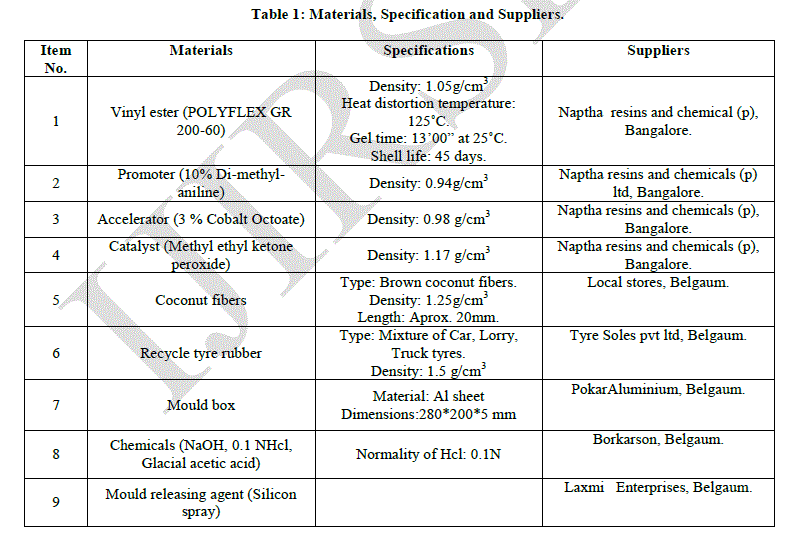 |
IV. SAMPLE PREPARATION |
| Acetylation treatment of Coconut fibers: |
| i. Immerse the coconut fibers in 18 % aqueous NaOH solution at 28ÃÂC for an hour. |
| ii. Wash these fibers several times with cold water and finally with acidified water (0.1 N Hcl). |
| iii. Dry out the fibers in air oven and then soaked in glacial acetic acid for an hour at the same temperature Sample preparation: |
| i. The mass of all the three materials (Vinyl ester, coconut fibers and rubber particles) are calculated for a particular composition combination. |
| ii. The materials are weighed for calculated masses on a digital weighing machine and mixed uniformly in a container by stirring. Accelerator, Promoter and catalyst are added (approx. 8 g each) and are stirred. |
| iii. The mixture is then poured in the mould box coated with mould releasing agent and is allowed to solidify at room temperature. |
| iv. The test samples of required dimensions (ASTM standards) are then cut after solidification. |
| The mould box is fabricated such that at least two good samples are obtained for each test and each composition. The varying composition and corresponding mould box is as shown in table 2 below (The calculation of the mass for various combination of composite composition is based on volume fraction equation). |
 |
| The figure 1(a) below shows one of the mould box kept at room temperature for solidification. The figure 1(b) and 1(c) below shows the finished sample for bending and tensile test respectively. |
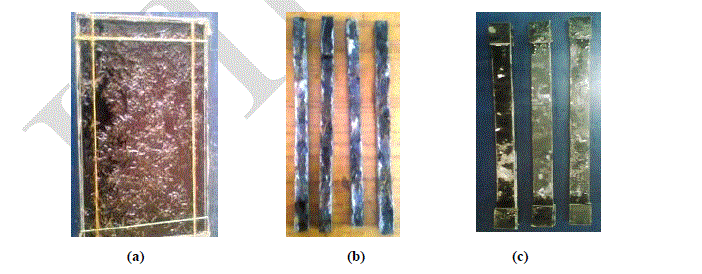 |
V. TESTS, RESULTS AND DISCUSSION |
| The obtained samples from mould boxes were tested for tensile and bending loads as per ASTM standards (ASTM D3039, D3039M and D790-02) on the Computerized Universal Testing Machine TUE-C- 400. |
| The figure 2 and figure 3 below shows the plot of tensile strength against the tested samples and tensile modulus against tested samples (tensile test) for Vinyl ester- coconut fiber composite respectively. |
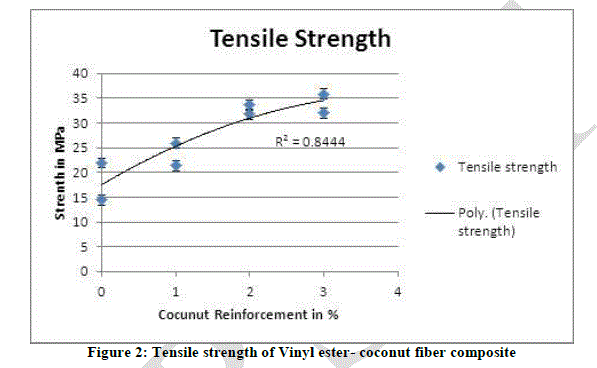 |
| It can be seen from figure 2 and figure 3 that the tensile strength and tensile modulus both are higher than plain vinyl ester and both properties increase as the composition of coconut fibers increases. A polynomial trend line is also shown in the above figures 2 and 3 which indicate increasing strength and modulus properties for tensile test. The R2 value tells that the trend line is quite accurate. |
| The figure 4 and figure 5 shows the plot of bending strength against the tested samples and bending modulus against tested samples (bending test) for Vinyl ester- coconut fiber composite respectively. |
 |
| It can be seen from figure 4 that the bending strength though initially is less than plain vinyl ester; it increases with increase in composition of coconut fibers. Figure 5 shows that the bending modulus is higher than plain vinyl ester and the property increase as the composition of coconut fibers increases. A polynomial trend line is also shown in the above figures 4 and 5 which indicate increasing strength and modulus properties for bending test. The R2 value shows that the trend line is quite accurate. |
| The figure 6 and figure 7 shows the plot of tensile strength against the tested samples and tensile modulus against tested samples (tensile test) for Vinyl ester- coconut fiber- rubber particles composite respectively. |
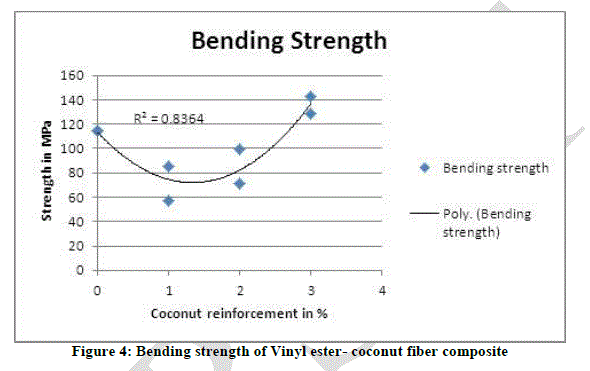 |
| It can be seen from figure 6 and figure 7 that the tensile strength and tensile modulus is less than vinyl ester - coconut fiber (2%) composite and both the properties decrease as the composition of rubber particles increases. A polynomial trend line is also shown in the above figures 6 and 7 which indicate decreasing strength and modulus properties for tensile test. The R2 value shows that the trend line is quite accurate. |
| The figure 8 and figure 9 shows the plot of bending strength against the tested samples and bending modulus against tested samples (bending test) for Vinyl ester- coconut fiber- rubber particles composite respectively. |
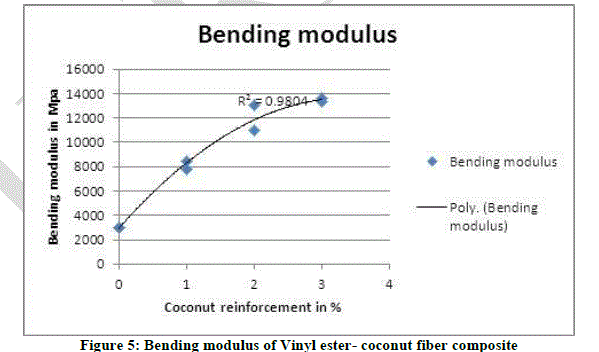 |
| It can be seen from figure 8 and figure 9 that the bending strength and bending modulus is less than vinyl ester - coconut fiber (2%) composite and both the properties decrease as the composition of rubber particles increases up to certain limit and then for 7% of rubber particles reinforcement it increases.. A polynomial trend line is also shown in the above figures 6 and 7 which indicate initial decreasing strength and modulus properties and then an increasing trend for bending test. The R2 value shows that the trend line is quite accurate. |
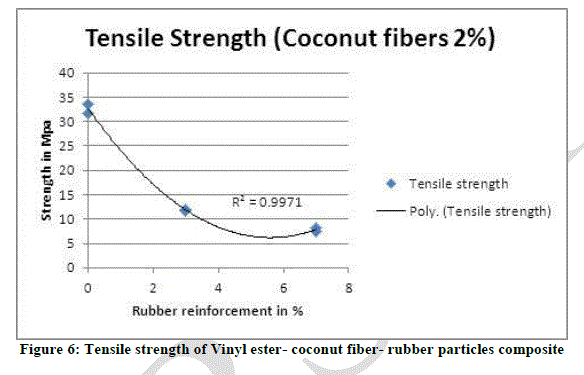 |
VI. CONCLUSION |
| The changing properties of both composites are seen from the results of tensile and bending tests. Vinyl estercoconut fibers composite seems to be more promising for practical applications. Coconut fibers and rubber particles based composites seems more suitable for bending applications. It also has to be noted that to recommend „vinyl ester- coconut fibersâ and „vinyl ester- coconut fibers- rubber particlesâ for real time applications tests other than tensile and bending like impact, density, hardness, wear, dynamic etc. need to be conducted. It should also be noted that more variation in composition of both the composites need to be prepared and tested for deeper understanding of its behavior. To sum up our work we conclude that both the composites seem promising to meet the changing trend of smart materials for real time applications. |
References |
|